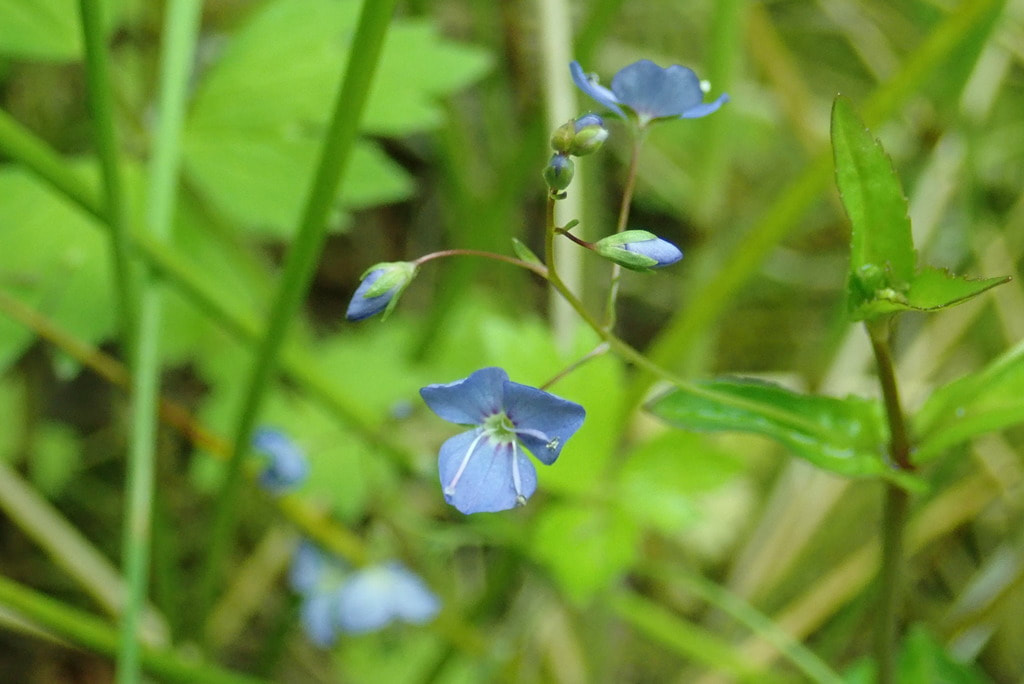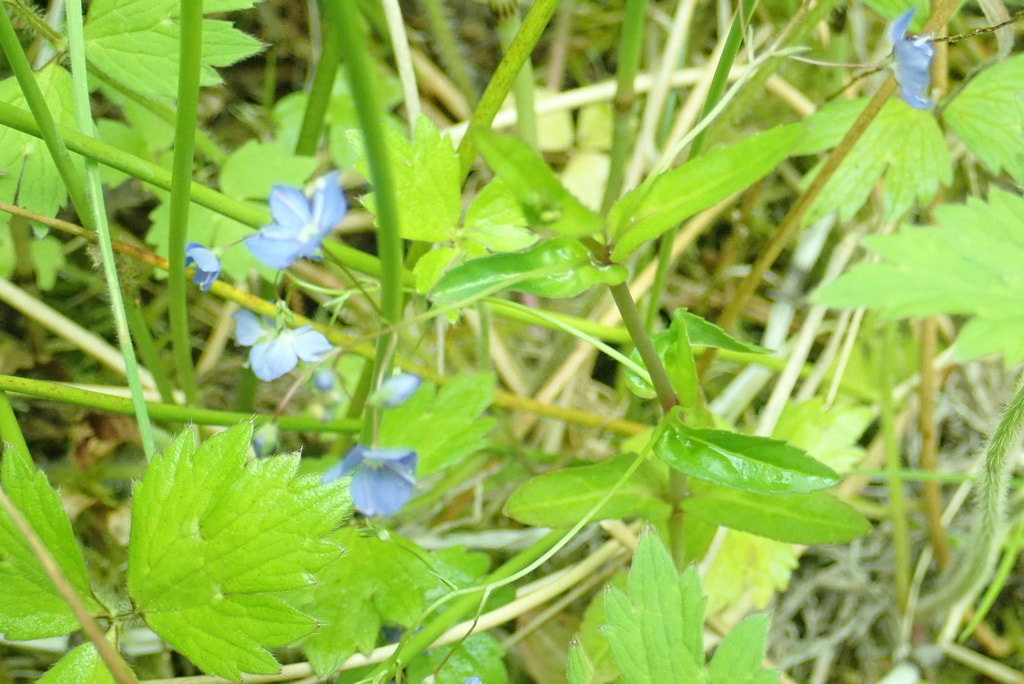American brooklime, American speedwell • Veronica americana, V. beccabunga var. americana
Identification
This perennial flowering herb grows from shallow, creeping rhizomes or forms roots from trailing stems. The 10-70 cm long stems are simple, upright or ascending, and hairless. There are usually 3-5 pairs of opposite leaves; leaves are oval and sharply pointed, with toothed edges and short stalks. The lilac to violet-coloured flowers have 4 lobes with 2 large stamens. The flowers are saucer-shaped and grow in long loose clusters along the stem.
Habitat & Range
American brooklime grows in wet ground such as shallow water, wet clearings, marshes, and along edges of springs, streams, and lakes. It is common at low to mid elevations in southern British Columbia and becomes increasingly infrequent northward.
Similar Species
American brooklime has also been identified by some sources as Veronica beccabunga var. americana. V. beccabunga, the European brooklime, is an introduced species from Europe however, and other sources separate it from the American species; these sources do not report European brooklime as present in 'British Columbia. European brooklime leaves are more rounded at the tip, and are widest closer to the tip; American brooklime leaves are widest closer to the stem and are more acutely pointed at the tip.
Bractless hedge-hyssop (Gratiola ebracteata) is a small annual plant which resembles the American brooklime with its lance-shaped leaves, and occupies similar wetland habitats. It can be distinguished by its smaller size and whitish flowers.
Human Uses
American brooklime leaves are edible and can be added as a salad green. Brooklimes are a potent blood purifier which have been used for centuries to treat urinary and kidney infections. Avoid gathering leaves growing in polluted water.
iNaturalist
https://www.inaturalist.org/taxa/57277-Veronica-americana
This perennial flowering herb grows from shallow, creeping rhizomes or forms roots from trailing stems. The 10-70 cm long stems are simple, upright or ascending, and hairless. There are usually 3-5 pairs of opposite leaves; leaves are oval and sharply pointed, with toothed edges and short stalks. The lilac to violet-coloured flowers have 4 lobes with 2 large stamens. The flowers are saucer-shaped and grow in long loose clusters along the stem.
Habitat & Range
American brooklime grows in wet ground such as shallow water, wet clearings, marshes, and along edges of springs, streams, and lakes. It is common at low to mid elevations in southern British Columbia and becomes increasingly infrequent northward.
Similar Species
American brooklime has also been identified by some sources as Veronica beccabunga var. americana. V. beccabunga, the European brooklime, is an introduced species from Europe however, and other sources separate it from the American species; these sources do not report European brooklime as present in 'British Columbia. European brooklime leaves are more rounded at the tip, and are widest closer to the tip; American brooklime leaves are widest closer to the stem and are more acutely pointed at the tip.
Bractless hedge-hyssop (Gratiola ebracteata) is a small annual plant which resembles the American brooklime with its lance-shaped leaves, and occupies similar wetland habitats. It can be distinguished by its smaller size and whitish flowers.
Human Uses
American brooklime leaves are edible and can be added as a salad green. Brooklimes are a potent blood purifier which have been used for centuries to treat urinary and kidney infections. Avoid gathering leaves growing in polluted water.
iNaturalist
https://www.inaturalist.org/taxa/57277-Veronica-americana
References
Veronica beccabunga L. In Klinkenberg, Brian. (Ed.). E-Flora BC: Electronic Atlas of the Plants of British Columbia. Lab for Advanced Spatial Analysis, Department of Geography, University of British Columbia, Vancouver. Accessed 25/11/2014.
Cao, L. and Alsip, P. (2018). Veronica beccabunga L.: U.S. Geological Survey Nonindigenous Aquatic Species Database. Gainesville, FL. Accessed 21/12/2018
Pojar, J and MacKinnon, A. (2005). Plants of Coastal British Columbia, Revised. Vancouver, BC: Lone Pine Publishing. P. 261.
Authors and editors of page
Paige Whitehead, Kelly Fretwell, and Brian Starzomski (2014).
Veronica beccabunga L. In Klinkenberg, Brian. (Ed.). E-Flora BC: Electronic Atlas of the Plants of British Columbia. Lab for Advanced Spatial Analysis, Department of Geography, University of British Columbia, Vancouver. Accessed 25/11/2014.
Cao, L. and Alsip, P. (2018). Veronica beccabunga L.: U.S. Geological Survey Nonindigenous Aquatic Species Database. Gainesville, FL. Accessed 21/12/2018
Pojar, J and MacKinnon, A. (2005). Plants of Coastal British Columbia, Revised. Vancouver, BC: Lone Pine Publishing. P. 261.
Authors and editors of page
Paige Whitehead, Kelly Fretwell, and Brian Starzomski (2014).







